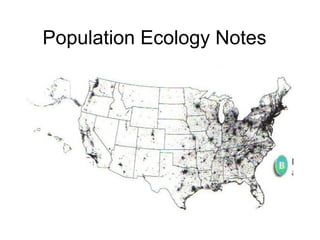Population ecology 2.07
•Download as PPT, PDF•
1 like•555 views
Report
Share
Report
Share

Recommended
More Related Content
What's hot
What's hot (20)
Similar to Population ecology 2.07
Similar to Population ecology 2.07 (20)
Complete Chapter 9:2 - Interactions Between Living Things

Complete Chapter 9:2 - Interactions Between Living Things
BIODIVERSITY KEY TO MORE VARIETY_BIO_X_Learner's Copy.pptx

BIODIVERSITY KEY TO MORE VARIETY_BIO_X_Learner's Copy.pptx
More from eziennker
More from eziennker (20)
Recently uploaded
God is a creative God Gen 1:1. All that He created was “good”, could also be translated “beautiful”. God created man in His own image Gen 1:27. Maths helps us discover the beauty that God has created in His world and, in turn, create beautiful designs to serve and enrich the lives of others.
Explore beautiful and ugly buildings. Mathematics helps us create beautiful d...

Explore beautiful and ugly buildings. Mathematics helps us create beautiful d...christianmathematics
https://app.box.com/s/7hlvjxjalkrik7fb082xx3jk7xd7liz3TỔNG ÔN TẬP THI VÀO LỚP 10 MÔN TIẾNG ANH NĂM HỌC 2023 - 2024 CÓ ĐÁP ÁN (NGỮ Â...

TỔNG ÔN TẬP THI VÀO LỚP 10 MÔN TIẾNG ANH NĂM HỌC 2023 - 2024 CÓ ĐÁP ÁN (NGỮ Â...Nguyen Thanh Tu Collection
Recently uploaded (20)
Unit-V; Pricing (Pharma Marketing Management).pptx

Unit-V; Pricing (Pharma Marketing Management).pptx
Python Notes for mca i year students osmania university.docx

Python Notes for mca i year students osmania university.docx
Explore beautiful and ugly buildings. Mathematics helps us create beautiful d...

Explore beautiful and ugly buildings. Mathematics helps us create beautiful d...
UGC NET Paper 1 Mathematical Reasoning & Aptitude.pdf

UGC NET Paper 1 Mathematical Reasoning & Aptitude.pdf
Fostering Friendships - Enhancing Social Bonds in the Classroom

Fostering Friendships - Enhancing Social Bonds in the Classroom
Jual Obat Aborsi Hongkong ( Asli No.1 ) 085657271886 Obat Penggugur Kandungan...

Jual Obat Aborsi Hongkong ( Asli No.1 ) 085657271886 Obat Penggugur Kandungan...
TỔNG ÔN TẬP THI VÀO LỚP 10 MÔN TIẾNG ANH NĂM HỌC 2023 - 2024 CÓ ĐÁP ÁN (NGỮ Â...

TỔNG ÔN TẬP THI VÀO LỚP 10 MÔN TIẾNG ANH NĂM HỌC 2023 - 2024 CÓ ĐÁP ÁN (NGỮ Â...
Kodo Millet PPT made by Ghanshyam bairwa college of Agriculture kumher bhara...

Kodo Millet PPT made by Ghanshyam bairwa college of Agriculture kumher bhara...
On National Teacher Day, meet the 2024-25 Kenan Fellows

On National Teacher Day, meet the 2024-25 Kenan Fellows
ICT Role in 21st Century Education & its Challenges.pptx

ICT Role in 21st Century Education & its Challenges.pptx
Unit-IV; Professional Sales Representative (PSR).pptx

Unit-IV; Professional Sales Representative (PSR).pptx
Basic Civil Engineering first year Notes- Chapter 4 Building.pptx

Basic Civil Engineering first year Notes- Chapter 4 Building.pptx
ICT role in 21st century education and it's challenges.

ICT role in 21st century education and it's challenges.
Population ecology 2.07
- 2. Population ecology 1. Populations can be described according to certain characteristics. - size of population - spacing (how organisms are arranged in a given area) - density – how many individuals there are in a specific area
- 4. Population Density 2. The size of a population occupying an area of a specific size is called population density - the more individuals = more dense of a population - less individuals = less dense of a population
- 7. Limiting Factors 3. Limiting factor – any biotic or abiotic factor that restricts the number of individuals in a population - examples: food, temperature, living space, other resources - populations cannot grow uncontrolled forever - what affects one population can affect others living in same area
- 8. Competition 4. Competition – contest among organisms to obtain the resources they need to survive and reproduce - population density increases = increase in competition
- 10. Carrying Capacity 5. Carrying capacity – the largest number of individuals an environment can support and maintain for a long period of time - when this happens – some individual may not be able to compete, and will die or have to find another place to live
- 13. Biotic Potential 6. Biotic potential – the number of individuals each female of a population can produce under the best possible conditions - plenty of food and shelter - ideal weather, no disease or enemies - populations never reach biotic potential in the wild
- 15. 7. Niche and habitat 1. Niche – all of an organism’s relationships with its environment (both biotic and abiotic factors) a. Relationships with others, its offspring, time of day its most active, and where it finds shelter b. An organism’s “lifestyle” – how it contributes to and fits into its environment 2. Habitat – the actual place an organism lives
- 17. Questions 1. How is habitat and niche different? 2. Give some examples of things that will limit a population’s growth? 3. What is the carrying capacity of a population? 4. What are the three characteristics used to describe populations?